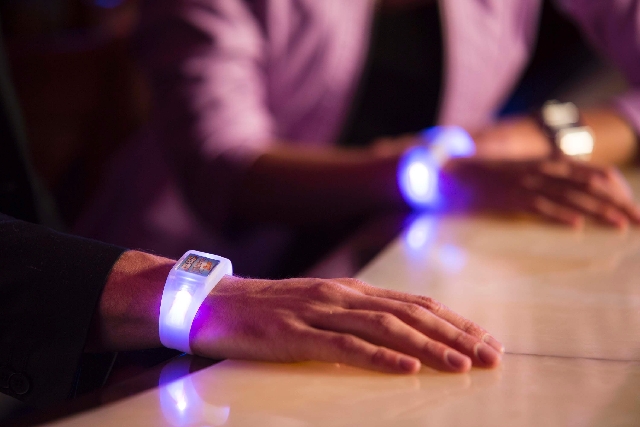Tech gurus to launch Kickstarter campaign for flashing bracelets
If you walk into Blue Martini and everyone has on flashing bracelets, don’t be alarmed.
You haven’t walked into a minirave, you’ve just entered into what could be the next step in nightlife stimulation. Or, if Cloudsona has its way, it could be the next big thing in your house.
Next week, Cloudsona is launching a Kickstarter campaign in an effort to raise around $88,000 to fund a personal version of its commercial flashing bracelets. Since December, the products have popped up in nightlife venues in Las Vegas and Los Angeles, but the company wants to expand beyond music festivals, bars and nightclubs, and open their potential market up to, well, everybody.
The silicon bracelets feature a removable chip that allows them to flash in sync with an iPad app. The commercial version uses an operating system that has to be set up at a venue, but the personal versions would run solely from an app.
In the commercial version, DJs or engineers touch colored squares on the app to match the music. Or, the venue can set a program and let it run without having to “play” the lights. The bracelets have been used locally at Body English and Blue Martini, and Cloudsona is targeting nighttime events, such as the GlowRun and Electric Daisy Carnival.
“We’re talking to a lot of the festival people like EDC, like Ultra Music Fest,” said Las Vegan Andre Nakaso, head of market and partner development for the company. “It’s perfect for that.”
The personalized version is called Wave, and the module can easily be transferred into a pendant for use in a dog collar or other specialty products. Users can assign colors to the band so you know who’s calling on the phone while running, for instance, without having to check your phone.
Founded in late 2011, Cloudsona is run by three tech guys who have a legacy of doing technology startups. There’s Hans Van Leeuwen, chief technology officer and engineer, who hails from Sostark, a tech company he founded in Amsterdam. Then there’s CEO Paul Fulton, who developed products for Cisco and helped develop Wi-Fi and Bluetooth tech. As for Nakaso, he also worked with Cisco and Sprint Nextel.
The products they helped create, while important for enterprise, weren’t fun, Nakaso said, and that’s where Cloudsona comes in.
“It’s really exciting. This is my ninth or 10th startup and even if you’ve done it a couple times before, it’s really exciting,” Nakaso said.
Although their tech isn’t just for partygoers, that is a large portion of Cloudsona’s target audience.
“A lot of the demographic we think is going to buy this are into electronic music. In Europe and Asia are some of the largest markets,” Nakaso said.
To that end, the group is using social media to spread the word internationally about their Kickstarter. The online funding platform is perfect for what they’re trying to accomplish, Nakaso said, because Kickstarter will give them a high probability of reaching tech people.
In little more than a month, you know whether you’ve earned the dough to continue or not.
There are about 30 Las Vegas-based projects on Kickstarter as this is being written, and of those five are fully funded. One of those projects is Jerry Grayson’s “Atlantis: The Second Age,” a tabletop role-playing game.
Grayson’s Kickstarter doesn’t end until May 9, but he’s already surpassed his goal of $6,500 and was well on his way to raising $8,500. In fact, Grayson’s project was funded in two days.
As for a project asking for funding to the tune of $88,000, Grayson said it can be done if you can sell yourself. One friend, for instance, raised $500,000 and another raised $120,000, both for role-playing game projects.
“If you are active in your community and you have a following that knows the work you do, they’re usually willing to give up a couple bucks to make it happen,” he explained.
Grayson, who has helped fund projects as well, said some ideas that aren’t great get funded because they’re presented well and the owners sell their idea.
“On Kickstarter, you have to get people excited enough to want you,” he said. “Some people can do it and some people can’t.”
Once putting up a project on Kickstarter, the work is just beginning. Owners have to tweet, post to Facebook and constantly check emails, because users will ask all types of questions. But if you do that, and can really sell your idea, chances are, you’ll be successful on Kickstarter no matter the dollar amount.
“I’ve seen some folks asking for grand amounts of money and they’ve succeeded,” Grayson said.
Last year, the Las Vegas-made Timber and Stone game was funded to the tune of $88,577, well above the owner’s target of $50,000.
“Its almost like creative Darwinism,” Grayson said of the site.
Contact reporter Laura Carroll at lcarroll@reviewjournal. com or 702-380-4588. Follow @lscvegas on Twitter.

















